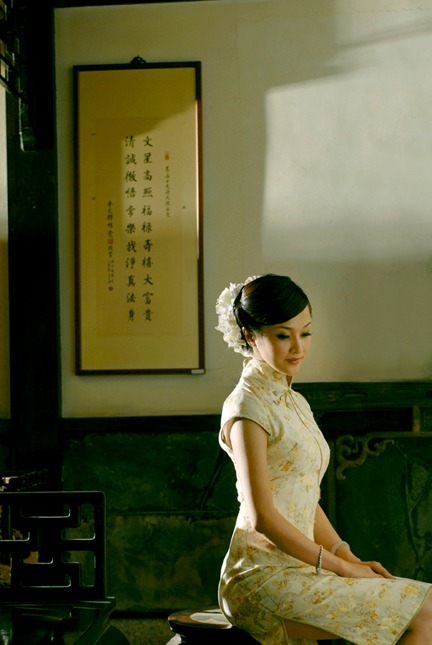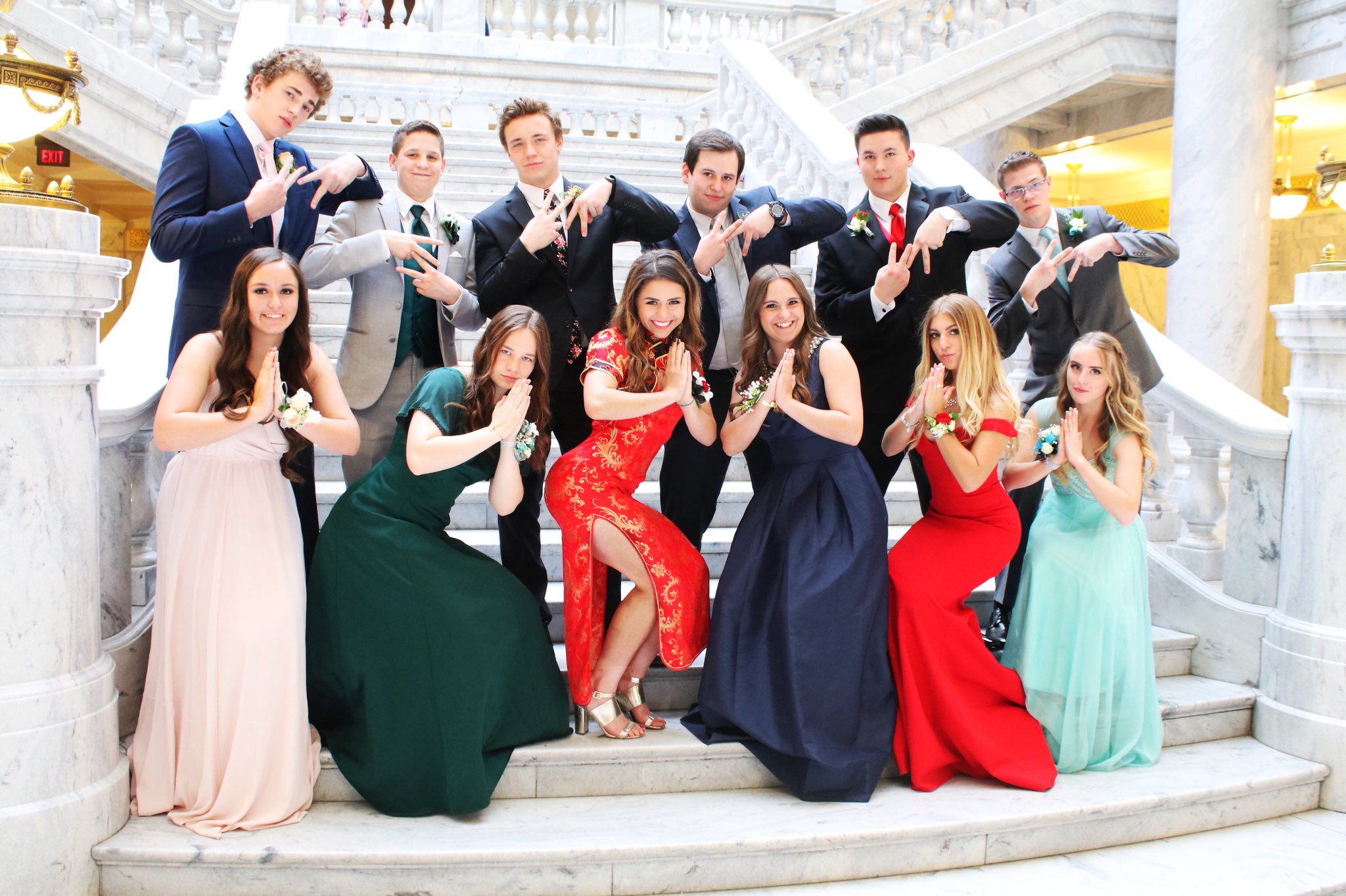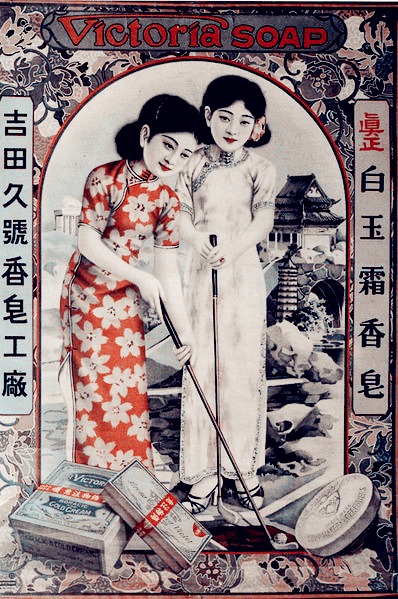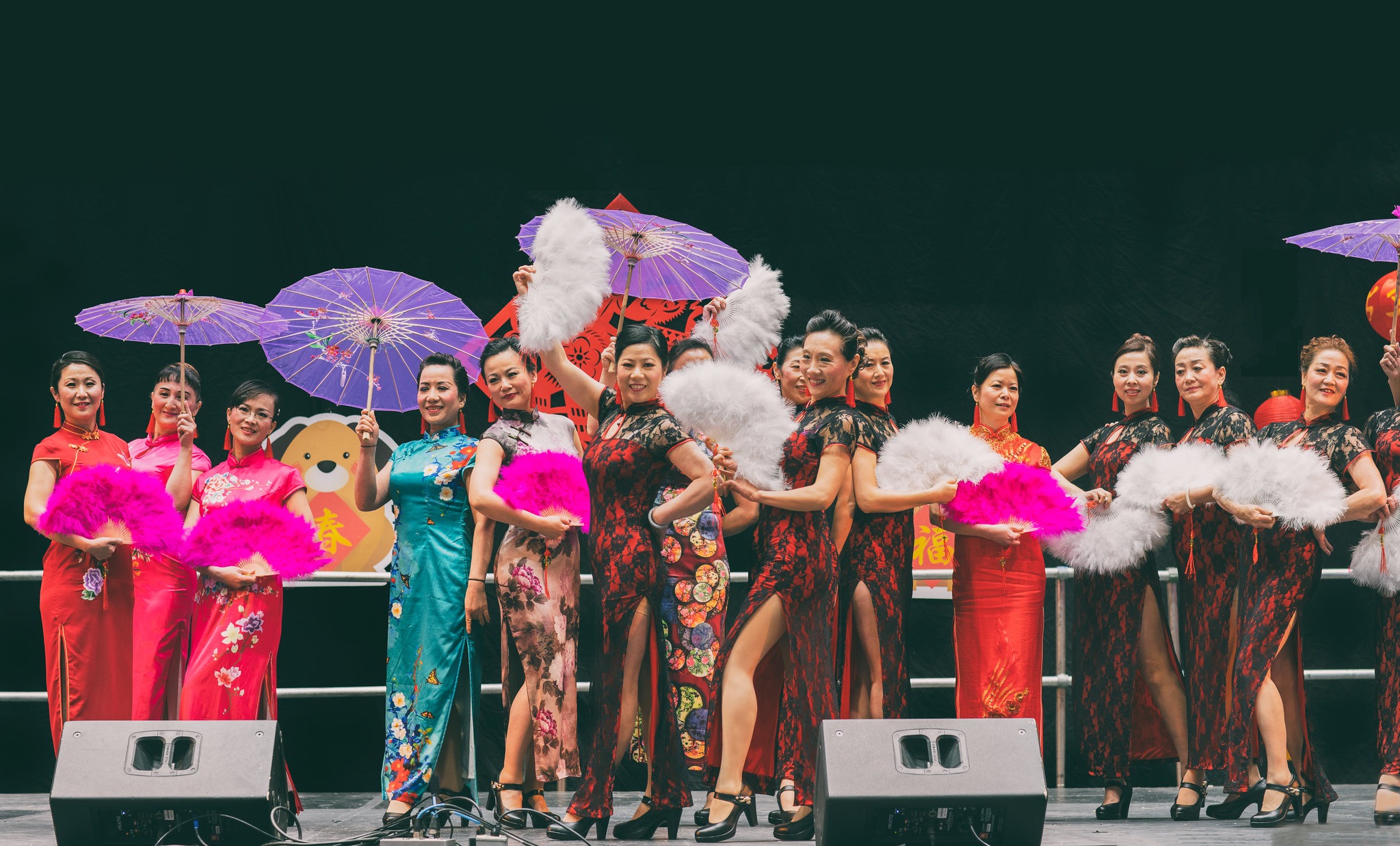The Short, Tortuous History of the Qipao

By Lisa Yin Zhang
Staff Writer
12/8/2019

In 2018, a white American teenager, Keziah Daum, wore a qipao to prom, and Twitter exploded. The qipao —high-necked and satiny, constructed of red-and-gold floral fabric with a slit up to the thigh — launched her into the center of a debate for which writers at every publication from Teen Vogue to the New York Times weighed in, calling it everything from appropriation to appreciation. On the “appreciation” side of the debate is the writer Anna Chen, who wrote in The Guardian that the outcry could be “compared with taking offence because someone in Asia wore a tuxedo.” Well, not exactly. But it is complicated. The qipao — or cheongsam, or zansae, or changshan, depending on where and when you are — has a tortuous and frankly confusing history that spans governments, revolutions, even continents. The mainland Chinese government has alternatively embraced it (albeit somewhat tenuously) and tried to stamp it out of existence. And yet the qipao has somehow — and somewhat miraculously — survived, symbolizing…it’s hard to say what, exactly. But it is certainly not, as Daum alleged, just “a fucking dress.”

Keziah Daum (center) at prom
“The qipao is a garment of no great antiquity,” wrote the scholar Antonia Finnane in “What Should Chinese Women Wear?: A National Problem,” in the journal Modern China. Though there are multiple theories regarding the origin of the qipao, scholars generally agree that it actually originated in Manchuria. During the early Qing Dynasty in China, lasting from 1644 to 1912 CE and ruled by the Manchu, all Han men were required to wear Manchu-style clothing called the chángshān, from which, by way of the Cantonese (chèuhng sàam), we got the English “cheongsam.” There was no equivalent legal requirement for women; formal dress for Han women typically consisted of a full jacket and pleated skirt over loose trousers. Though the Qing eventually softened its rules, requiring the changshan only for government officials, it remained popular with men and eventually women as well. The female form of the garment eventually came to be called qipao — literally, “banner gown” — because it was worn by Manchu women, “the women of the banners.” The garment was nearly unisex, with its length, bagginess, and lack of a slit all conspiring to hide the shape of the body, differentiating it from the form we might recognize today.

An early form of the qipao
The qipao was carried into a more recognizable form in the early Republic in Shanghai, known as the city that “cared about clothes, not people.” If we take Roland Barthes’ imperative to “think…of the magazine as a machine that makes fashion,” then Shanghai was churning in full force. The fashion industry in 1920s Shanghai was characterized by mechanized textile production; a robust advertising culture cultivated in billboards, newspapers, and pictorial magazines; the rise of the retail outlet; competition between local and foreign products; and fashion parades. The writer Eileen Chang dated the appearance of the first qipao in a guise we might recognize to 1921, but it was not until the end of the decade that it was heavily represented in advertisements and magazines. In that melting pot of a city — the French, Americans, and British had all carved out concessions — the qipao was influenced by Western fashion. Sleeveless, high-neck versions became popular, and some qipao were hemmed with black lace in the style of ballgowns.

Scene from Lust, Caution, a film based on Eileen Chang’s novella
In the meantime, the qipao, with its unisex roots, became a tool for equality. As women were allowed into the education system as both students and teachers, the qipao began to be worn as a kind of political statement for gender equality, and were often dyed cool, restrained, masculine colors. Here, the old Confucian dictate of the difference between sexes (男女有别) began to dissolve. But the qipao’s significance derived not so much from the number of women who wore it, but rather the type of woman who did. It was popular with the emerging middle class, who had some education, some financial means, and were socially and culturally attuned. They were the female face of progressive China, and their clothing choices signified modernity itself. Henrik Ibsen’s A Doll’s House, though released close to half a century prior, became enormously popular as Shanghai was roiled by a literary renaissance that sent progressive young men pining for the so-called “new woman,” often clad in a qipao, deserting their poor bound-footed, “backward” wives.

An old Shanghai advertisement
But why does the qipao matter so much?
Gender politics can have national implications. Women serve as a metaphor, an alias, a cipher. The theorist Partha Chaterjee wrote, “the [British] colonial mind was able to transform [the] figure of the Indian woman into a sign of the inherently oppressive and unfree nature of the entire cultural condition of the country.” Clothing therefore became a weapon in the struggle for power, often between colonizer and colonized. The colonizer used clothes to impose its own authority, and alternatively fantasized about stripping the metonymic colonized woman of her indigenous dress. “[The] rape of the Algerian woman in the dream of Europe,” writes Frantz Fanon, “is always preceded by a rending of the veil.” The battle over the place of the qipao, then, is, in effect, the battle for the symbol of a nation. In 1895, when negotiating the settlement of the first Sino-Japanese war, Li Hongzhang asked Ito Hirobumi how Japan could possibly abandon the clothes of its ancestors. Decades later, Mao Zedong reportedly said, “We Chinese have our own customs. Why should we follow others?” He chose to wear, instead of the Western lounge suit, the Sun Yat-sen jacket with trousers, which came to be dubbed the Mao suit.
When Mao Zedong refused to wear a Western suit, he was declaring a difference. In donning the Mao suit, he was declaring a Chinese nationalistic tradition, a link with its own revolutionary history. What women wore, by contrast, was nearly historically meaningless. The qipao was not entirely banned after Liberation, but it became decidedly less fashionable, worn almost exclusively by bourgeoisie women (while the bourgeoisie was still allowed to exist), occasionally appearing in propaganda to signal leisure, and becoming formal dress for banquets and state functions. Certainly the qipao’s association with the Manchu reign was buried. In general, gender-distinctive clothing was frowned upon. During the 1960s and 70s, only subtle details — the location of the trouser fastening, the length of the hair — differentiated the styles of men and women. And when Deng Xiaoping’s reforms were implemented in the late 1970s, the qipao was no longer worn even by wives at state functions, and had been largely relegated to the uniform for hotel staff. “Our right and proper national dress,” wrote Finnane, “had for some reason or other been reduced to this.”
The qipao was not entirely banned after Liberation, but it became decidedly less fashionable, worn almost exclusively by bourgeoisie women (while the bourgeoisie was still allowed to exist).
But more liberal outposts kept the qipao even as it was being quashed on the mainland. In the British colony of Hong Kong, it became everyday wear in the 50s and 60s, typically paired with the high heels, leather clutch, and white gloves of European fashion. Emigrants to Taiwan, where the Nationalists ruled, brought the qipao with them as well — where it too retired, after a couple decades of popularity, into purely formal wear.
Back on the mainland, the qipao became even more complicated. In the 1980s, the jackets and pants of the Mao era were slowly disappearing. Many predicted that the qipao, with its flattering silhouette, would again become in vogue. Indeed, there was a brief qipao craze. But China was somewhat late to the game: professional modeling was virtually unknown before the 1980s. The first class of China’s first school for models assembled in 1981, too shy to remove even their jackets. Pierre Cardin, a French fashion designer instrumental in establishing the school, infamously strode through the dressing room and tore down the curtain separating the male and female models. “This might be regarded as a seminal moment,” Finnane wrote, “involving the subordination of conventional ethics…to the demands of one of the world’s greatest consumer industries.”
Indeed, Cardin’s nationality was perhaps the most precedent-setting aspect of the act. While Chinese designers riffing on the qipao received some due — the designer Liu Ping won first prize in the Second Chinese Fashion Culture show in 1985 with a qipao adorned with a giant bow at the crotch — a strange phenomenon began. The designer Feng Ling pastiched elements of the Mao suit and the qipao, creating novel garments that referenced China’s past — yet 70% of her customers were foreigners. Her own comments evince the kind of pastoralism China was generally relegated to: “My clothes are very China, yet at the same time very modern.” The Hong Kong designer William Tang expressed bewilderment that his qipao-esque garments on the Paris catwalk failed to inspire, while French designers with similar designs made headlines internationally. Somehow it was not the design itself but what it represented — and who was representing it. Finnane suggests, for instance, that Chinese designers face the obstacle of being Chinese — perceived by the West as being limited in individuality and creativity. And certainly the Chinese were baffled when the model Lu Yan, who had monolids and a broad nose, was headhunted by French modeling agents. But of course, the French were looking for something else, something exotic — even primitivist.
That sort of sentiment is partly what inspired a new breed of Chinese ethno-nationalists to reject the qipao as a national garment entirely. The Han identity, which makes up more than 90% of China’s population, has often been described as an “empty,” “invisible,” or “unmarked category,” leading to what Sinologist Lucian Pye identified as “the inchoate and incoherent nature of Chinese nationalism.” For a contingent of these nationalists, radicalized on websites like Hanwang, the Han ethnicity — despite mixing with ethnic minorities as early as the Spring and Autumn Period — is “one of the purest blooded races in the world,” with over 5,000 years of racial inheritance. For some supporters of the movement, the qipao is the symbol of alien rule under the Qing dynasty, an “uncivilized, barbarian race.” The restoration of Han clothing, argued Lin Minhui, a blogger, was a fundamental part of the movement to revive the Han race. In 2007, a member of the Chinese People’s Political Consultative Conference even tried to pass a motion declaring hanfu, or clothing from the Han dynasty, China’s national costume.
For some Chinese nationalists, the qipao is the symbol of alien rule under the Qing dynasty, an “uncivilized, barbarian race.”
How’s it viewed outside China, though? In the US, ethnic Chinese women connect the garment to their ancestors. “I saw qipao on my grandma in old family pictures,” recounts one third-generation Chinese-American student, explaining why she had herself purchased a qipao. “I am proud of it…and the heritage it represents.” A mixed-race woman similarly recounted, “[The qipao] was the uniform my mama put on every Sunday.” Even if worn more performatively than authentically, more symbolically than substantively, the qipao forms a sort of ritual bond to a culture and a past. In Malaysia and Singapore, though, it’s not viewed as a relic: young ethnic Chinese women typically own multiple pairs, often wearing them for special occasions like weddings and balls, and, of course, Chinese festivals.

Picture Credit: Koichiro Ohba
So what is the qipao, exactly, and what does it represent? If it’s truly a national costume of China, it’s certainly an ambivalent one, brought to the mainland through Manchurian conquest; metamorphosing through history, sometimes adapting to Western fashions, sometimes championing progressive ideals; carried into the present by Taiwan, a state that, according to the Chinese Communist Party, does not even exist. If the qipao signals a coherent Chinese past, it’s an imagined one. But what’s wrong with that? History is complicated, and continues to be. The qipao is writing its own future even as I write its history. Now seen largely only during special occasions, or in the service and hospitality industries, it is a hyper-sexualized and somewhat nostalgic stylization of an imagined past. But it also signals the capacity of the female body to move from the rural to the metropole, of the ability to enter the “consumer citizenship of today’s China,” signaling a femininity situated in a commercial, cosmopolitan future.

Chinese New Year celebrations in Edmonton, Canada, 2018 (Picture Credit: IQRemix)
My mother, a Chinese immigrant, came to me last week to show me a pair of qipaos she had bought for work. I was startled at the choice — I’d rarely ever seen a qipao worn even for formal occasions, and even then usually only at events with older Chinese women present. But she had always been well-dressed, always daring, always proud. One of the qipaos was white, floral, with red fastenings down the left hand side of the bust. I rubbed its silken fabric between my thumb and forefinger, admiring its sheen. “It’s beautiful,” I told her, and I meant it. But where did she buy it? Not from a rickety storefront in Old Shanghai, where an ancient tailor honed his generational craft. Not even in either of the two Chinatowns near where she lives, here in New York. She bought it, she told me, on Amazon, and it had shipped in two days.
